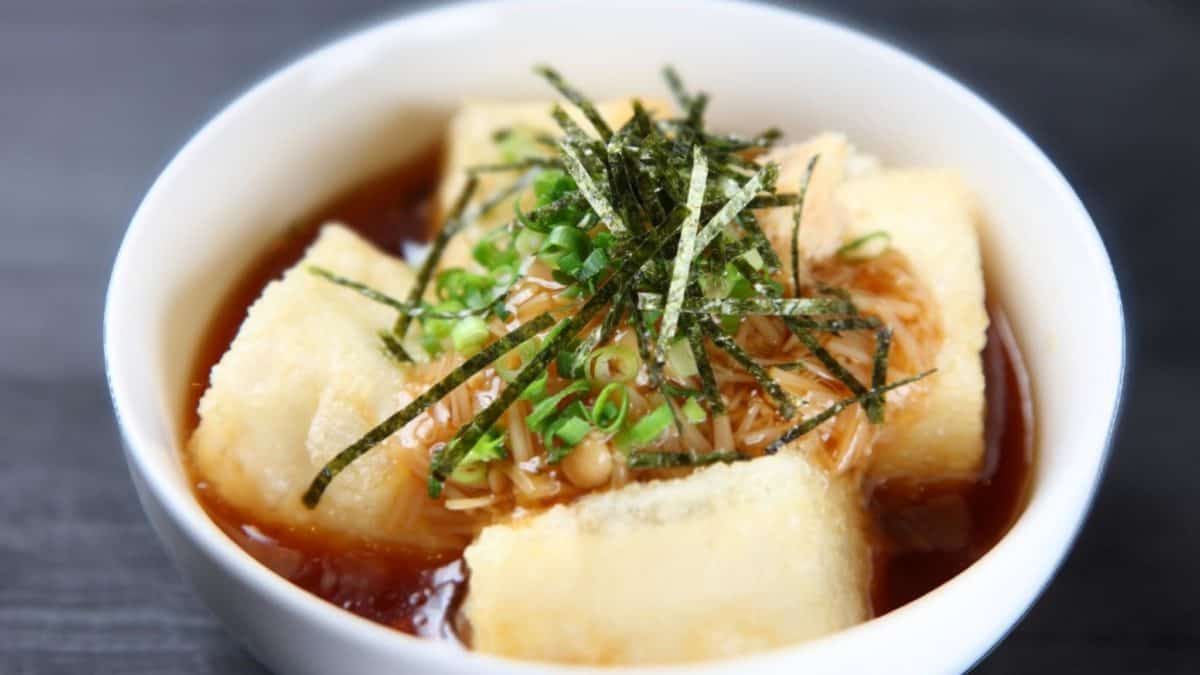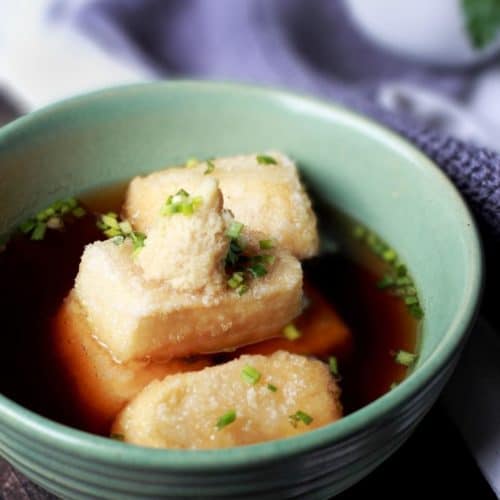Agedashi Tofu Recipe: Salty Umami Sauce With Fried Tofu
If you like flavorful sauce, and you like deep-fried tofu, then there’s no better dish than agedashi tofu.
This recipe has a delicious dashi-based sauce and combined with the tenderness of the tofu will make every bite just melt in your mouth. The secret in this recipe is just a little bit of cornstarch and enough soy sauce for saltiness.
Let’s start making it!



Check out our new cookbook
Bitemybun's family recipes with complete meal planner and recipe guide.
Try it out for free with Kindle Unlimited:
Read for freeIn this post we'll cover:
Agedashi tofu recipe
Ingredients
- 14 ounces of regular tofu (or Japanese "momen" tofu)
- 1 cup dashi stock
- 2 tbsp soy sauce
- 2 tbsp mirin
- ½ cup cornstarch
- 1 tbsp vegetable oil for frying
- 1 inch piece of daikon grated
- 1 scallion chopped
- 2 tbsp katsuobushi bonito flakes for garnish (optional)
- 1 tsp shichimi togarashi (Japanese chili flakes) for garnish (optional)
Instructions
- After soaking the tofu with water for 5-10 minutes, drain the water over the sink, Cut it into 6-8 pieces of cubes and transfer to a clean plate, then microwave it for 3 minutes on high settings.
- Remove the tofu from the microwave oven and place it in another clean plate once again, then let it dehydrate. Add a coat of cornstarch to fully coat the pieces.
- Place a small saucepan on the stove and pour in the Dashi stock, mirin and soy sauce, then turn on the stove to medium heat until the sauce mix gets warm enough. Now turn off the stove and cover the saucepan with a lid.
- Pour cooking oil in a nonstick frying pan and fill it at about 1/4 to 1/2 of an inch and set the heat to 171.11 – 176.67 °Celsius. Put in the tofu slowly and deep fry them for about 5 minutes or until they become golden brown in color.
- Once done then transfer the tofu to a clean plate lined with paper towels to drain the oil off of the tofu. Garnish the tofu with chopped scallion and grated daikon, then pour some sauce on the top to finish.
- Garnish with bonito flakes and Japanese chile flakes, if desired.
Cooking tips
When you place the tofu on the plate, put it on a paper towel so it can dehydrate faster. You don’t have to do this but you might have to wait a little longer for it to dry out.
When cutting the tofu, make sure to cut it into even pieces so that they cook evenly, and if you want a really crisp coating, you can use a little cornstarch as coating.
Substitutes
You can’t substitute dashi in agedashi because it’s the essential ingredient (you can’t make it without tofu either of course).
But there are a few things you might not have and you can substitute:
Mirin substitute for agedashi
If you don’t have any mirin, you can also use some sake in the same amount with a teaspoon of sugar, or if you don’t have sake you can also do with dry white wine.
These substitutes have alchohol in them and the recipe doesn’t call for much cooking, so add the sake or white wine into the pan first and let it cook for at least 30 seconds to let the alcohol evaporate, then add in the other ingredients.
Daikon substitute for agedashi
If you want a bit of daikon in your agedashi but don’t have any, you can substitute with some white radish or even just some regular radish.
Katsuobushi substitute for agedashi
If you don’t have any katsuobushi, you can use some dried fish in very small pieces.
Tempura flakes are a good substitute too but you also might not have those. If you don’t have any of these, I think skipping the katsuobushi altogether is the best option.
Shichimi togarashi substitute for agedashi
If you don’t have any shichimi, you can use some cayenne pepper or even some chili flakes.
This substitute won’t give you the same flavor as shichimi but it will add a bit of spice to the dish.
An easy substitute to get the same depth of flavor is to use 3/4 teaspoon cayenne pepper with 1/4 teaspoon of white sesame seeds for every teaspoon of togarashi.
How to serve agedashi tofu
Agedashi tofu is usually served with the dipping sauce on the side but if you want, you can also pour the sauce over the tofu.
It’s up to you!
If you want to get really fancy, you can also garnish with some thinly sliced green onion, some nori strips, or even some caviar.
But agedashi tofu is usually pretty simple and humble, so don’t go overboard with the garnishes.
Agedashi tofu is a dish that I usually eat as a snack or as a light meal. It’s something that I can easily eat on my own, but it’s also great to share with others.
I like to eat agedashi tofu when I’m feeling a bit hungry but don’t want anything too heavy, and it’s also a good dish to have when I’m not sure what I feel like eating, but it can also be served as part of a larger Japanese meal.
How to store leftover agedashi tofu
If you have any leftovers, you can store them in the fridge for up to 2 days.
Just make sure to put them in an airtight container so that they don’t dry out.
You can also reheat them in the microwave or in a pan, but be careful not to overcook them or they will become tough.
Agedashi tofu is a dish that is best eaten fresh, so try to eat it within a day or two of making it.
It’s also essential to store the tofu separate from the sauce so if you think you might have leftovers, don’t pour the sauce over all of the tofu or you won’t be able to store it, it will get too soggy.
Similar dishes to agedashi tofu
There are a few other dishes that are similar to agedashi tofu, and they all use the same basic method of frying the tofu in a tempura batter.
These other dishes might not be exactly the same as agedashi tofu but they are all delicious in their own right.
- Tempura tofu: Tempura tofu is basically just fried tofu in a tempura batter. It’s usually served with a dipping sauce on the side, and it’s a great dish to share.
- Kinpira gobo: Kinpira gobo is a dish made with fried burdock root, and it’s usually served with a sweet and sour sauce on the side.
- Nasu dengaku: Nasu dengaku is a dish made with fried eggplant, and it’s usually served with a miso sauce on top.
- Imam budjang: Imam budjang is a dish made with fried eggplant, and it’s usually served with a sweet and sour sauce on the side.
Conclusion
It’s such a light dish that’s easy to make as a snack or a small side dish. An incredible thing to have in your repertoire to crank out when you have people coming over for example.
Check out our new cookbook
Bitemybun's family recipes with complete meal planner and recipe guide.
Try it out for free with Kindle Unlimited:
Read for freeJoost Nusselder, the founder of Bite My Bun is a content marketer, dad and loves trying out new food with Japanese food at the heart of his passion, and together with his team he's been creating in-depth blog articles since 2016 to help loyal readers with recipes and cooking tips.
